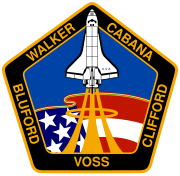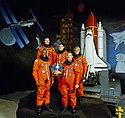STS-53
| STS-53 | |||||
 | |||||
| Uppdrag | ? | ||||
|---|---|---|---|---|---|
| Rymdfärja | Discovery (15)[1] | ||||
| NSSDC-ID | 1992-086A[2] | ||||
| Färdens tid | 7 dagar, 7 timmar, 19 minuter, 47 sekunder | ||||
| Uppskjutning | |||||
| Startplats | Startplatta 39A vid Kennedy Space Center i Florida | ||||
| Start | 2 december 1992, 8:24 a.m. EST | ||||
| Landning | |||||
| Landningsplats | Runway 22, Edwards AFB, California | ||||
| Landning | 9 december 1992, 3:43.17 p.m. EST | ||||
| Omloppsbana | |||||
| Varv | 115 st[3] | ||||
| Apogeum | 376 km | ||||
| Perigeum | 365 km | ||||
| Banlutning | 57,0° | ||||
| Sträcka | 4,800 miljoner km | ||||
| Besättning | |||||
| Befälhavare | David M. Walker (3) | ||||
| Pilot | Robert D. Cabana (2) | ||||
| Uppdragsspecialister | Guion S. Bluford (4) James S. Voss (2) Michael R. Clifford (1) | ||||
 | |||||
| Kronologi Rymdfärjeprogrammet | |||||
| |||||
STS-53 var en flygning i det amerikanska rymdfärjeprogrammet, den femtonde flygningen med rymdfärjan Discovery. Den sköts upp från Pad 39B vid Kennedy Space Center i Florida den 2 december 1992. Efter drygt sju dagar i omloppsbana runt jorden återinträdde rymdfärjan i jordens atmosfär och landade vid Edwards Air Force Base i Kalifornien.
Flygningen gjordes på uppdrag av USA:s försvarsdepartement.
Se även
Referenser
- ^ NASA Space Shuttle Launch Archive Arkiverad 21 april 2012 hämtat från the Wayback Machine., läst 28 juli 2016.
- ^ ”NASA Space Science Data Coordinated Archive” (på engelska). NASA. https://nssdc.gsfc.nasa.gov/nmc/spacecraft/display.action?id=1992-086A. Läst 19 mars 2020.
- ^ Manned Astronautics - Figures & Facts Arkiverad 4 mars 2016 hämtat från the Wayback Machine., läst 28 juli 2016.
Externa länkar
 Wikimedia Commons har media som rör STS-53.
Wikimedia Commons har media som rör STS-53.
| ||||||||
| ||||||||||||||||||||||||||||||||
Media som används på denna webbplats
Emblem of Nasa's STS-53 mission
- Designed by the crewmembers, the STS-53 insignia shows the Space Shuttle Discovery rising to new achievements as it trails the symbol of the Astronaut Office against a backdrop of the American flag. The five stars and three stripes also serve to symbolize the mission designation (STS-53) and America's continuing commitment to world leadership in space. The pentagonal shape of the patch represents the Department of Defense (DOD) and its support of the Space Shuttle Program. The band delineating the flag from space includes the four colors of the military services of the crewmembers. The names of the flight crewmembers are located along the border of the patch. They are Commander David M. Walker, Pilot Robert D. Cabana, Mission Specialist (MS) Guion S. Bluford, MS James S. Voss, and MS Michael R. U. Clifford. Each crewmember contributed to the design of the insignia.
STS-54 Mission Insignia
STS-52 Columbia, Orbiter Vehicle (OV) 102, crew insignia (logo), the Official insignia of the NASA STS-52 mission, features a large gold star to symbolize the crew's mission on the frontiers of space. A gold star is often used to symbolize the frontier period of the American West. The red star in the shape of the Greek letter lambda represents both the laser measurements to be taken from the Laser Geodynamic Satellite (LAGEOS II) and the Lambda Point Experiment, which is part of the United States Microgravity Payload (USMP-1). The LAGEOS II is a joint Italian \ United States (U.S.) satellite project intended to further our understanding of global plate tectonics. The USMP-1 is a microgravity facility which has French and U.S. experiments designed to test the theory of cooperative phase transitions and to study the solid\liquid interface of a metallic alloy in the low gravity environment. The remote manipulator system (RMS) arm and maple leaf are emblematic of the Canadian payload specialist Steven MacLean.
Författare/Upphovsman: Pascal (Flickr user: pasukaru76), Licens: CC0
Vostok spacecraft replica at the Technik Museum Speyer, Germany.
The STS-53 crew portrait included astronauts (front left to right): Guion S. Bluford, and James S. Voss, mission specialists. On the back row, left to right, are David M. Walker, commander; Robert D. Cabana, Pilot; and Michael R. (Rick) Clifford, mission specialist. The crew launched aboard the Space Shuttle Discovery on December 2, 1992 at 8:24:00 am (EST). This mission marked the final classified shuttle flight for the Department of Defense (DOD).







